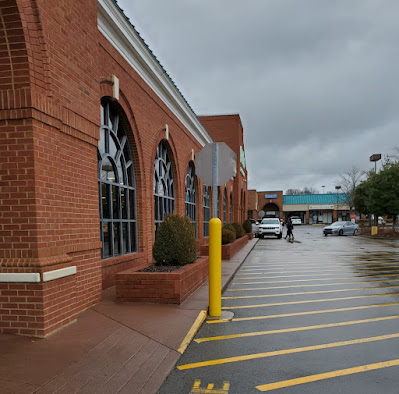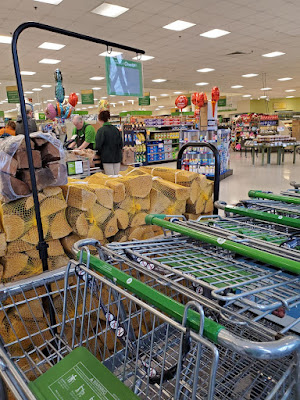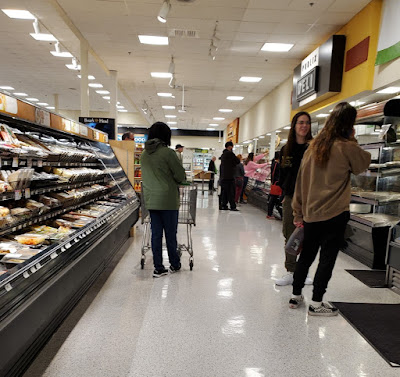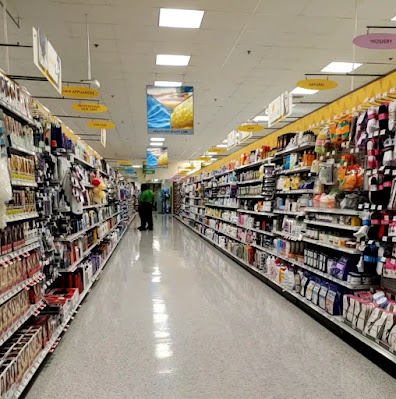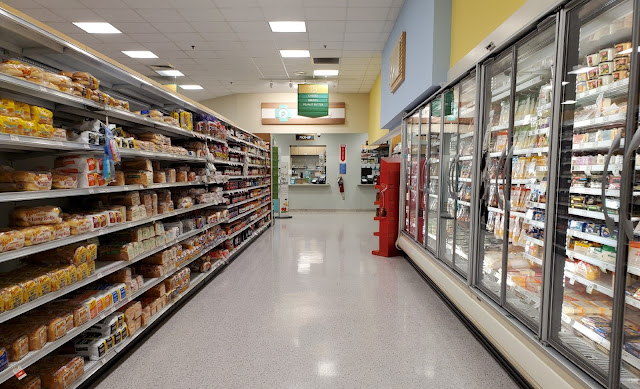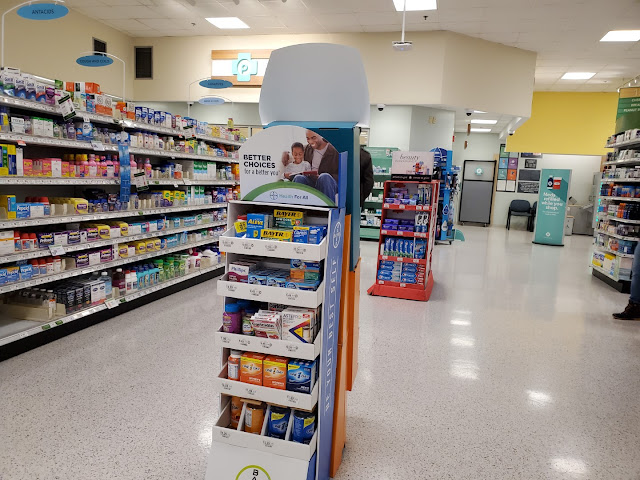Publix #119
Former Albertsons #4729 | Former FoodMax Supercenter
Indian Lake Marketplace
110 Indian Lake Boulevard
Hendersonville, TN 37075-6206
We Don't Talk About Bruno-no-no-no
Hello, and welcome to another edition of "The Sing Oil Blogger takes over The Albertsons Florida Blog." Although that title may not be great, I think most of you will agree that the subject of today's post is; that's also why today's post officially kicks off my brand new series: O Bruno's, Where Art Thou? Publix #119 in particular has quite the unique history, and I felt that it was only fitting for me to explore this store here on The Albertsons Florida Blog. Let me explain.
You may remember my post last year covering Publix #1306 / former Albertsons #4428 which was my first experience researching Publix stores in Florida's Capital City. It was at that time when I discovered Bruno's, once Alabama's dominant grocer, had a notable presence in Tallahassee. This intrigue led me to cover the Sunshine State's one-and-only Pubno's, while leaving me with loads of questions on how the long-lost Publix #689 looked while it was open.
 |
| Courtesy Sky City: Retail History - Former Bruno's #5 - Montgomery, AL |
In May 1995, the Bruno's family sold the chain to investment firm Kohlberg Kravis Roberts & Co. who also owned Safeway, Fred Meyer, and Stop & Shop at the time. The $1.2 billion deal would only continue the supermarket chain's slow death spiral, as a 1998 Wall Street Journal article states that "An effort [by KKR] to convert the chain from the "everyday-low-price" format to the so-called frequent-shopper program backfired when Bruno's cost-conscious customers deserted the stores. This miscalculation, pulling down same-store sales by more than 10%, coincided with a well-advertised push by Bruno's rivals to open new stores."
The Bankruptcy
That same article goes on to describe the Chapter 11 bankruptcy Bruno's filed the day $21 million in bond coupon payments came due. Stocks for the company were trading at $1.75 a share at the time the news broke, down from $12 a share only three years prior. Bruno's operated 218 supermarkets at the beginning of 1998, with 123 in Alabama, 50 in Georgia, 17 in Florida, 20 in Tennessee, and 8 in Mississippi. That number would slowly dwindle as the bankruptcy drug on . . .
It is stated that the company had $780,808,000 in total assets, but $1,204,000,000 in total liabilities, meaning that they had over $400 million in unsecured debt . . . that's a lot of money!
 |
| Courtesy Sky City: Retail History - Former Bruno's Supercenter #248 - Birmingham, AL |
- The Value Format. Value stores are designed to attract value conscious customers through a combination of low prices, good customer service, and a broad range of product offerings. Approximately 111 of the Company's 218 stores are operated under the value format. Six of the value stores are Supercenters. The Company's value stores are operated under the names Food World and FoodMax.
Food World. The Company operates 79 stores under the Food World name. These stores are typically high volume stores designed to appeal to a broad range of customers. With a primary emphasis on value, these stores offer low pricing along with an extensive variety of name-brand merchandise and specialty departments. Food World stores are promoted through television, newspaper, and radio advertising. The Company's Food World stores average approximately 44,000 in total square feet.
- FoodMax. The Company operates 32 stores under the FoodMax name. These stores are large with an open design, warehouse-style ceilings, and expanded perishable departments. These stores emphasize low prices and an extensive product selection while achieving low overhead through reduced staffing. The Company's FoodMax stores average approximately 52,000 in total square feet.
The Combination Format. The Company's combination format consists of approximately 54 stores, including 10 Supercenter stores, operating under the name Bruno's. These stores generally have a substantial breadth and depth of product offerings and are widely regarded as the quality and service leaders in the markets in which they are located. The combination stores typically contain expanded produce, bakery, delicatessen, and gourmet foods not generally found in conventional supermarkets, a variety of health and beauty care products normally found in large drug stores, and a wide range of general merchandise items. These stores average approximately 51,000 in total square feet and are generally located in suburban markets.
- The Neighborhood Format. The Company's neighborhood format consists of approximately 53 stores operating primarily under the names Piggly Wiggly and Food Fair. The neighborhood stores are generally smaller than the Company's other supermarkets and emphasize friendly service and promotional pricing. For its neighborhood stores, which are generally located in small- to medium-sized towns and suburban neighborhoods, the Company advertises primarily through direct mail and weekly advertised specials.
Piggly Wiggly. The Company's Piggly Wiggly stores are located in small- to medium-sized towns in central and southern Georgia. These stores average approximately 34,000 in total square feet and are promoted primarily through weekly advertised specials.
Food Fair. Food Fair stores, like Piggly Wiggly, are designed to operate with lower overhead and competitive pricing in suburban neighborhoods and towns that will not support the volume necessary for a large supermarket. All of the Company's Food Fair stores are located in Alabama, and these stores average approximately 29,000 in total square feet."
The Bruno's story has many more chapters to read (including a couple that repeat), but for now we will put a pin in this saga and focus on the life of this particular store.
However, if you are impatient, I'd advise you to check out this informative article from AL.com which I used as an outline for my research. The Sky City: Retail History blog, mentioned with the photos above, also has a few posts about the former chain that are worth looking at.
Background
 |
| Logo Courtesy Ryan Brotherston |
Shortly after conducting my research on Publix #1427, I learned that Publix owned a number of other former Bruno's stores in the Nashville area. To make matters more bizarre, all seven of these locations were purchased from none other than Albertsons. It wasn't until I was planning a trip to the Music City when I began to examine the history of these locations and of the former Alabama chain itself. It turns out that Bruno's entered Middle Tennessee in 1987 under their FoodMax brand by building a store on Murfreesboro Pike.
The store we will be looking at today was officially announced at the end of 1992 when permits were filed with the city; however, it appears that this store had been in the works since at least 1991. While I was never able to find a grand opening date, the new FoodMax Supercenter opened by November 28, 1993, according to a sales flyer I was able to find.
 |
| Logo Courtesy Ryan Brotherston |
Bruno's was still a small fish in the Nashville grocery market when they opened this location in 1993, which would likely explain why they built a number of large and flashy stores in the metro. The company would go on to build 11 stores in the region: seven of which operated under the FoodMax name, three which opened as Bruno's stores, and one which was never completed. By 1996, The word on the street was that Bruno's would convert all of its Nashville area stores to the flagship banner; however, this never happened and only newly-constructed locations received the upmarket moniker. This led me to believe that KKR's acquisition was the reason for the brand identity crisis, but that apparently wasn't the case. Bruno's claimed that they often didn't pick the name for a store "until one of the last steps right before the grand opening" way back in a 1992 article.
 |
| The Tennessean (Newspapers.com) - August 1, 1998 |
By 1998, Bruno's only held 10% of the Nashville grocery market, second place to Kroger with 46%. This, along with the fact that the company was six-months deep in Chapter 11 bankruptcy proceedings, led to the decision that the Alabama grocer would exit the state of Tennessee entirely by selling 15 Bruno's and FoodMax stores to Albertsons. This comes on the heels of Bruno's also selling the 10-store, Memphis-based Seessel's to Albertsons in January 1998.
 |
| The Tennessean (Newspapers.com) - August 1, 1998 |
In addition to the eleven Nashville-area stores, four Chattanooga FoodMax locations were sold, which included a single location in Fort Oglethorpe, GA. Not only did the Idaho chain enter Nashville for the first time, but it also gained the singular location it has ever operated in The Peach State.
 |
| The Tennessean (Newspapers.com) - August 30, 1998 |
Probably the most interesting piece regarding the Albertsons acquisition is a line from the Tennessean article above:
"From the outside it's hard to tell. Front the inside, too . . .
At 10:30 a.m. FoodMax is lightly sprinkled with customers. It still looks like FoodMax.
But at a closer glance employees have swapped the khaki and green uniforms for Albertson's khaki and navy. The grocery bags read Albertson's too." - The Tennessean
It appears that Albertsons opted to keep all of the stores open immediately following the acquisition while slowly phasing in any new branding. Food Lion followed a similar practice when they purchased 62 stores from Southeastern Grocers a few years back, but the move isn't exactly a great way for a new company to generate buzz around entering a new market. This leads me to wonder if these stores were ever fully remodeled under Albertsons.
 |
| The Tennessean (Newspapers.com) - Photo of former Albertsons #4729 - March 14, 2002 |
By the time 2002 rolled around, Albertsons' Nashville area stores had garnered a whopping 7.3% market share, fourth behind Kroger (45.9%), Walmart (10.4%), and Food Lion (9.6%). Shockingly, the company seems to have done worse in Nashville than even the chaotic Bruno's would have. This was likely one of the prime culprits in the debt-laden company calling it quits in Tennessee only four years after entering the state. All eleven Nashville-area Albertsons stores would permanently close by April 5, 2002, and at least one additional location never made it out of the planning phase. These moves were part of a larger cost-cutting effort that included the complete withdrawal from other metropolitan areas such as Memphis, Houston, and San Antonio.
Needless to say, the Bruno's and Albertsons disasters could not have come at a better time for Publix.
 |
| The Tennessean (Newspapers.com) - June 21, 2002 |
On June 20, 2002, Publix announced that it would acquire seven Nashville-area stores from Albertsons, with six of those originally belonging to Bruno's.
Critics were skeptical as to whether Publix could offer something different to the Music City, but others noted how "In Atlanta they pretty much bulldozed the market . . . In the early '90s they had no stores there; now they are No. 2 in the market (to Kroger)." - Chuck Gilmer, editor of The Shelby Report, to The Tennessean Publix eventually opened their first two stores in Tennessee on October 2, 2002, with #119 following suit on April 9, 2003.
 |
| The Tennessean (Newspapers.com) - June 21, 2002 |
In the following decade, Publix opened a total of 36 stores in Tennessee (two of which eventually closed) as they proved to be a formidable competitor in the Nashville, Chattanooga, and more recently Knoxville areas.
I'd also like to point out that this isn't the only store #119 to have existed for the chain. The original location was at the current site of store #591 in Sea Ranch Lakes, FL, and was demolished in the late-1990's to make way for its replacement.
Publix decided to recycle store numbers for a short time in the early-2000's which is why the Hendersonville store didn't get a number in the 800 block. I'd guess that all of the numbers in the 800-900 range were allocated by the time these stores were acquired, and the 900-1000 block had already been reserved for the Crispers chain (when Publix purchased a stake earlier in 2002). It appears that Publix's computer systems or business procedures couldn't handle 4-digit store numbers, so the new Tennessee stores were all given recycled numbers between 100-200. By 2004, Publix began assigning new stores numbers above 1000.
Now that we know a bit about this store's past, let's take a look at its present state.
The Store
Located about 40 minutes northeast of downtown Nashville, this Publix is well within the realm of suburbia and isn't even in the same county as Nashville proper. The area seemed relatively nice, despite the fact that I'm not all that familiar with the Nashville area. I do know, however, that many of the ultra-affluent suburbs are south of town and include the likes of Brentwood and Franklin (don't worry, we'll get to tour stores down there as well).
If you look closely at the bricks surrounding the Publix sign, you may notice that some of them are still discolored from the Albertsons and possibly FoodMax logos which hung here over two decades ago.
My recent Bruno's research kick did yield a lot of interesting information; however, it mostly brought to light how disorganized and haphazard the company was throughout the 1990's. This store appears to have an identical layout to the Capital Circle Publix (#689), but the façade is a different story. The symmetrical turrets encasing a central vestibule showcases one of Bruno's most recognizable designs despite the fact that this location only operated as a FoodMax under the chain. If your head is spinning, join the club!
The general look may be familiar, but the execution is a departure from the similar buildings I've come across. Those locations Alabama and Georgia use a different, widened arch shape and a narrower vestibule. The aforementioned stores also look different from aerial views which seems to indicate they used different interior layouts.
On the other hand, the Hendersonville store's façade only matches two other Bruno's stores I've found: Columbia, SC, and Kerry Forrest Parkway (Tallahassee). Neither of those buildings remain supermarkets and both appear to have been heavily modified since their Bruno's days, but I think the interior layout of the Columbia store would have matched the Hendersonville Publix. Fellow researcher Henry H. and I have begun to call this layout the "updated FoodMax / Food World" since it seems to have predominantly been used with 1990's-built stores from those two brands.
Ultimately, we may never know what those long-lost locations looked like on the inside, but as we've seen with numerous other Publixsons on this blog, Publix often likes to keep things the way they were when they take over somebody else's store.
Our first indication of this is the presence of Bruno's original swinging doors and curved vestibule ceiling. This is certainly a unique look for a Publix; I'd also imagine a replacement solution would be very expensive. Regardless, surprised Publix still hasn't found a way to install their typical sliding doors here over the last 22-years.
Turning a bit toward the left, we see this store's collection of firewood along with a mix of circa 2012 and more modern Technibilt shopping carts.
Something about the "easy to compare" sign in the photo above caught my attention as hearkening back to Publix's 2011 "Love to Shop Here. Love to Save Here." campaign, even though I think the former is much newer.
I feel like it would be too much of a coincidence for both this store and #689 to have the same floral and produce layout (considering #119 was acquired by Publix 4-years after #689), so I think this is where Bruno's would have placed both departments.
 |
| Courtesy of Robert B. on Foursquare - Publix #689 - Tallahassee, FL - July 11, 2013 |
It's also possible that Publix has kept Bruno's original ceiling grid in place. The photo we have of this side of the store from Tallahassee shows similar florescent light fixtures but a slightly different dropped ceiling grid. I also have a feeling that the décor in the Hendersonville store looked strikingly similar to our pictures of #689 when it opened; however, I'll have to save my reasoning for a future post.
Back to the present, we see this store's decently-sized (for a Publix, at least) Floral department and the corresponding signage. I still haven't figured out why some Bamboo stores receive this sign, while others get one reminiscent of the Invigorate package – maybe it had to do with space constraints?
We'll take one last look at the vestibule, Instacart staging area, and checkout lines before moving on.
Before the Evergreen era, it wasn't common to find a Publix with the produce department in the front right corner of the store: that's a surefire way for a novice to identify an older store Publix didn't build!
At least Publix still does a good job of making themselves feel at home in these acquired stores. The faux terrazzo really works wonders to "Publixify" the space.
Turning to the left, we can start to see the deli come into view. You may notice something over there that is a bit out of place – more on that later.
Here's another view of the front speedway with the produce department in the foreground. Bananas were 64¢ a pound for those who are curious.
A deluxe 1990's grocery store wouldn't be complete without a fresh-cut produce counter, and this former FoodMax was no exception. This space was located in the back of the produce department, just before the wall curved around to the deli.
The best surprise from this department was a familiar friend days gone by: a Classy Market 1.0 / Kiwi fresh produce sign. You may remember that we saw this same sign back in Publix #1498, but at least it makes sense in a store that opened in 2002 rather than one from 2015!
Continuing on, we'll take our first look down the remainder of the grand aisle toward the back right corner of the store. I thought it was odd for Publix to have the "Deli Now Hiring" banner hanging from the wall, considering I've never seen a banner like that displayed inside a Publix, but I guess Tennessee stores just do things differently.
Wine is located just opposite the deli and bakery, which creates the perfect setup for a last-minute charcuterie party! I feel like this placement for the beverage used to be more common in Publix stores a decade-or-so ago.
Conversely, wine has only been in this spot for roughly 7-years. AFB pointed out on my last Tennessee Publix post that grocery store wine sales were only legalized in the state back in 2016, which is shocking considering how I've grown up seeing the phenomena. Prohibition-era laws still have a bizarre way of popping up in various jurisdictions, like how Oxford, Mississippi, only legalized the sale of refrigerated beer in 2013.
You'll notice that the wine placard for this aisle doesn't match the remaining category cards which is a result of this store last fully remodeling roughly 2-years before the new law went into effect. We saw a similar color mismatch in Chattanooga a few weeks ago.
Something about the orange signage Publix uses on their specialty cheese coolers always reminds me of Winn-Dixie's Transformational package – maybe it is just the similar color scheme.
On the other side of that cooler, we see several people Lingering in front of the deli. Meanwhile, the friends that I drug along were all standing behind me chatting with their fountain drinks.
Speaking of the deli, here is a better view of the Pub Sub and fried chicken portion of that counter.
The back right corner of this store is where customers can find seafood and baked goods, which is exactly what Bruno's intended.
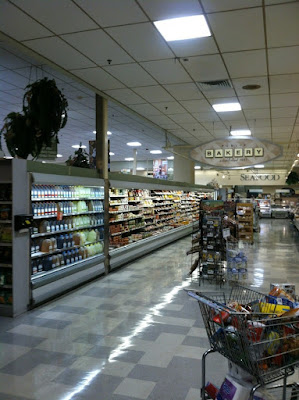 |
| Courtesy of Ato F. (Foursquare) - Publix #689 - Tallahassee, FL - June 1, 2013 |
Publix #689 featured an identical configuration when it was still in business, but it looks like the Hendersonville store swapped the tall refrigerated cases for the shorter ones we saw earlier to open up the space.
Publix appears to have done a thorough remodel when they moved into this space, like they did with #1165, considering every department uses the same checkered grey tile pattern we would find in a circa 2002 Publix-build.
We'll take one last look at the bakery, which is the perfect time for me to point out the blue "cakes" sign placed in front of the bamboo backing (you may have to zoom in to see it). Publix likes to use this style of secondary signage in other stores, but I recall most locations using brown lettering as opposed to blue.
It's interesting that Bruno's used a vaulted ceiling over their grocery aisles in a similar move to what Publix favored at the time.
Beginning our meander through the grocery aisles, we'll take a look at the tea and cereal located on aisle two . . .
. . . followed by the condiments and baking needs on aisle four. Is Publix implying that butter pickles can serve as a shortening substitute in red velvet cake?
Just like former Albertsons #4441 and Publix #1427, this store currently features the circa 2014 Bamboo aisle signs. These always make me do a double take based on how similar they look to the ones used with Sienna!
Speaking of the aisle signs, this store appears to have previously used some of the Atlanta Division's infamous painted tri-siders (like we saw at Publix #515) which were likely recycled from this store's opening in 2003.
Next up, we'll take a quick look at snacks and chips on aisle six . . .
. . . followed by the most novel idea I saw in the entire store: putting chips in tubular canisters! What is this "Pringle" thing you speak of?
On a positive note, for my friends, they were able to find some Ale-8-One (aka Ale 8, according to The Sing Oil Sidekick) on aisle seven which is apparently something you have to try if you visit Kentucky (or Tennessee, I suppose). I'm typically not a fan of soft drinks myself, but I tried a sip of the ginger ale-style drink and thought it, well, tasted like ginger ale. Regardless, it's still fun to come across regional brands like this in various stores.
It looks like we could host a party on aisle 9 with all of those plastic utensils and Solo cups!
Returning to the back, we see the frozen department come into view along with the hallway to the restrooms.
 |
| Courtesy of Karen P. (Foursquare) - Publix #689 - Tallahassee, FL - June 10, 2012 |
This shot from the Tallahassee Pubno's was taken from a similar angle and shows a familiar raised ceiling in addition to a Wavy Pastels-adorned endcap cooler.
Aisle 10 is the final one to run under the raised ceiling, and for some reason this photo makes the aisle seem wider than most.
We'll pop our heads out the end of the aisle for a quick look at this store's historic photo collage – it wouldn't be a Bamboo or Invigorate store tour without one!
Now, turning to the right, we see this store's customer service and pharmacy counters tucked way over yonder past the checkout lines (notice how all three of the standard lines are staffed in addition to the four self-checkout machines – ehm, Kroger).
While I was walking down the freezer aisle, I noticed a subtle detail which almost certainly dates back to FoodMax:
There was a subtly curved piece of molding surrounding the two frozen foods aisles. Take note of this feature because we will see it again at a later date . . .
I was really digging that piece of accent molding; I just wonder what it looked like in 1993. I feel like it would look really cool if it also featured some uplighting to shine on the ceiling above it
Another fun surprise was an additional Classy Market 1.0 sign hanging out on the side of the beer cooler: so chill!
Continuing on down the aisle, we see where cold beer transitions into frozen foods.
Meanwhile, aisle 12 looks pretty similar to its neighbor. The fact that the freezers don't quite line up with the ceiling detailing makes me wonder if these aisles used to be narrower, or if the line of case freezers between aisles 11 and 12 used to be narrower coffin coolers (picture this typical Winn-Dixie layout).
This store may not be as large as some of the other Publixsons we have seen on this blog, but Publix still followed one of its familiar tactics by piling water bottles in random voids around the store.
Greetings, from your local Publixsono's Hallmark aisle! This isn't the most greeting cards I've seen in a Publix, but it still shows how the company wasn't exactly pressed for space in this store.
Off in the back left corner, Publix decided to angle the typical Entenmann's snack cakes display to try and fill this space as well.
Or maybe, this is just an implied design cue to direct shoppers away from the pricey fresh eggs so they will instead opt to buy a jug of yellow Softsoap for their next baking adventure. Who knows?
Speaking of soap, let's venture down aisle 14 to take a look at the health and beauty care items.
AFB and YonWoo recently covered former Albertsons #4431 / Publix #1329 in Clearwater where we got to see possibly the last example of a Publix with the early-2010's backlit aisle toppers. Unfortunately, this store's toppers are much more modern, but we can still see two vintage "Health and Beauty Care" signs hanging from the ceiling. The three stock images (lipstick, popcorn, and water) just so happen to match those used on the old backlit aisle toppers and roughly correlate with the categories of product. Water / blue falls above the oral care products, popcorn / yellow above hair care and soap, while lipstick / pink is above cosmetics and hosiery. I'm surprised that I'll still occasionally encounter one (or two) of these old hanging signs despite the fact that Publix has nearly eradicated the old aisle toppers. If any of y'all are aware of other stores which still use the old H&BA or curved wine aisle toppers, I'm all ears!
Dairy rounds out aisle 15 of this store, followed by the pharmacy off in the distance.
I also wanted to point out how the blue paint used in this store's dairy department may be the standard issue for the Bamboo package (Sherwin Williams' Something Blue), it differs from what I've seen in several other stores including #599. The signage in the Ansley Mall store uses a much more vibrant shade of blue than what we see here.
The pharmacy also happens to have received signage featuring the 2018 logo, which likely means this store received a light remodel around 2018-2019. That same remodel also probably added the cooler doors and motion sensors we see on the right along with the self-checkout machines we see up front.
I'm guessing FoodMax's pharmacy would've been in the same location we see here, but I have absolutely nothing to base that off of.
Turing back toward the registers, we see a few short pharmaceutical aisles between me and the customer service counter.
I do wonder how many of those fluffy socks and long sleeve shirts Publix ends up selling in a year.
Back out front, I wanted to capture a close up of a very subtle Bruno's trait: the wall sconces. I doubt many people who come to this store could tell you anything is special about these, but my recent random Bruno's research tells me otherwise.
You know what they say: "back in Sumner County, our Pubno's is second to none!" (You're welcome, Sing Oil Sidekick.)
I just love how symmetrical this style of Bruno's façade is! I also feel like I've read somewhere that this is considered "Charleston" style architecture yet have no knowledge of my own to back that up.
The last remnant we'll examine is the road sign facing Highway 31E. This also, you guessed it, dates back to 1993. Of all the things I've come across at former Bruno's locations, this sign design is probably the most common trait to remain in place. In my post on Publix #1427, I neglected to mention how that store also continues to boast a similar sign which even features that shopping center's original name: Centervillage.
I'll close out this post with an interesting long-exposure photo of this store I found on Publix's website. Publix recently revamped their store listing page and removed these pictures, but they can still be found by inserting the store number at the end of this link: https://cutpcdnwimages.azureedge.net/images/static/StoreFront/00<insert store number here>-828x498.png
The example for this photo would be: https://cutpcdnwimages.azureedge.net/images/static/StoreFront/000119-828x498.png
So, what did you think of this Publixsono's? It has quite the past, but hopefully Publix will continue to operate this unique location well into the future.
I was personally surprised at how little information is available online regarding Bruno's, so that's what inspired me to launch this new series in attempt to solve some of the mysteries I've found. Furthermore, if you didn't get a full grasp on all of the history I outlined at the beginning of the post, don't fret. I plan to dive deeper into several of the topics I dug up and paint a better understanding of the breadth of the former corporation. All of these posts will be linked back to my More Than Convenience page when I get around to writing them.
Make sure to check back here in two weeks to see what else AFB has up his sleeve and be sure to stop by my own blog next weekend to see where Sing (and Bruno's) will appear next.
Until then,
- The Sing Oil Blogger




